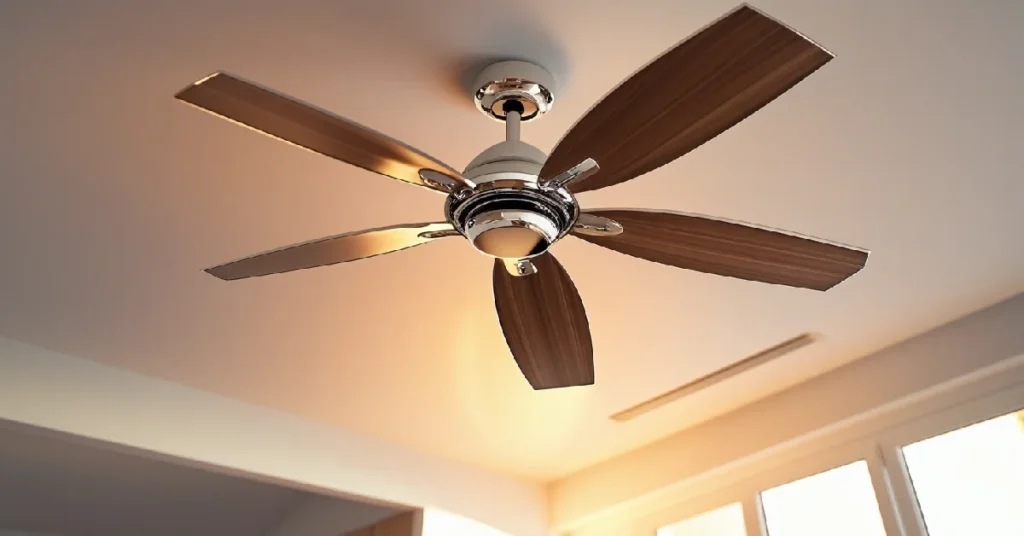Ceiling fans are a staple in many homes, providing comfort and airflow during hot weather. However, one common issue homeowners face is why ceiling fan run slow.
This can be frustrating, especially when you rely on your fan for cooling. Studies show that many ceiling fan users experience performance issues, with slow operation being one of the most reported problems.
In this article, we will explore the reasons behind slow ceiling fan operation and provide practical solutions to fix the problem. By understanding these factors, you can ensure your ceiling fan operates efficiently and effectively, enhancing your home’s comfort.
What is a Ceiling Fan?

A ceiling fan is a mechanical device suspended from the ceiling that uses rotating blades to circulate air in a room.
They come in various designs and sizes and can be equipped with additional features such as lights or remote controls.
Also Read: Which Ceiling Fan is Best
How Do Ceiling Fans Work?
Ceiling fans use an electric motor that turns the blades to create airflow. The speed at which the blades rotate determines how much air is moved.
Typically, ceiling fans have multiple speed settings, allowing users to adjust airflow according to their needs.
Common Reasons Why Ceiling Fan Run Slowly
Ceiling fans are designed to provide consistent airflow, but various factors can cause them to run slowly. Understanding these reasons can help you troubleshoot and resolve the issues effectively.
#1. Electrical Issues
Electrical problems are one of the most common reasons for a ceiling fan running slowly. If the voltage supplied to the fan is lower than required, it can significantly reduce its speed and lead to ceiling fan problems.
- Voltage Fluctuations: Inconsistent voltage levels can lead to inadequate power supply, causing the fan to operate at reduced speeds. It’s essential to check if your home’s electrical system is functioning correctly and providing stable voltage.
- Wiring Problems: Loose or damaged wiring connections can also impede the flow of electricity to the fan. Regularly inspecting the wiring for any signs of wear or damage is crucial for maintaining optimal performance.
#2. Capacitor Problems
The capacitor in a ceiling fan is crucial for regulating its speed. A faulty capacitor can lead to slow operation or even prevent the fan from starting altogether.
- Signs of Failure: Homeowners may notice humming noises or difficulty starting the fan, which are indicators of capacitor issues. If you suspect a failing capacitor, it’s advisable to consult your user manual for specific troubleshooting steps.
- Replacement Process: The motor or any other appliance components is crucial for maintaining optimal performance. for the motor or any other appliance components is crucial for maintaining optimal performance.: Replacing a faulty capacitor is generally straightforward but requires some electrical knowledge. Ensure you purchase a compatible replacement and follow safety precautions when handling electrical components.
#3. Motor Malfunctions
The motor is the heart of any ceiling fan, and if it malfunctions, it can significantly affect the ceiling fan’s speed and performance.
- Overheating Issues: Motors can overheat due to prolonged use or lack of maintenance, leading to slower speeds. Regularly checking for overheating signs and allowing the motor to cool down can help prolong its lifespan.
- Lubrication Needs: A well-lubricated motor operates more efficiently. If your fan has been running for an extended period without maintenance, consider applying the appropriate lubricant as specified in your user manual.
#4. Dust and Dirt Accumulation
Over time, dust and dirt can accumulate on the blades and motor of a ceiling fan, hindering its performance.
- Impact on Airflow: Dust buildup on blades not only affects aesthetics but also reduces airflow efficiency, making the fan work harder than necessary. This can result in slower speeds and increased energy consumption.
- Cleaning Routine: Establishing a regular cleaning routine—wiping down blades with a damp cloth every month—can help maintain optimal airflow and efficiency.
#5. Incorrect Installation
Improper installation can lead to various issues, including slow operation.
- Mounting Height: If a ceiling fan is installed too close to the ceiling or at an inappropriate height, it may not circulate air effectively. Ensuring that the fan is mounted at least 7 feet above the floor is ideal for optimal airflow.
- Leveling Issues: An unbalanced or improperly leveled fan may wobble during operation, which can reduce its efficiency and slow speed. Checking that the fan is level during installation can prevent these problems.
Also Read: Goldmedal Electricals Opus Prime BLDC Fan
Step-by-Step Guide to Troubleshooting
If your ceiling fan is running slow, follow this detailed troubleshooting guide to identify and resolve potential issues:
- Check Power Supply: To ensure that the voltage is sufficient for your ceiling fan to run at high speed. Ensure that the fan is receiving adequate power by checking if other electrical devices on the same circuit are functioning properly.
- Inspect Wiring: Look for any loose screws that may affect the ceiling fan’s performance. Look for any visible damage or loose connections in the wiring that could affect power delivery. Tighten any loose wires and replace damaged ones as necessary.
- Test Capacitor: If you have electrical knowledge, use a multimeter to test the capacitor’s functionality. If it’s faulty, consider replacing it following safety guidelines.
- Examine Motor: Listen for unusual noises from the motor that could indicate problems such as overheating or mechanical failure. Allow it to cool down if overheating occurs.
- Clean Fan Blades: Wipe down the blades and motor housing with a damp cloth to remove dust buildup that could be affecting performance.
- Check Installation: Verify that the fan is mounted at an appropriate height and is level; adjust if necessary.
- Lubricate the Motor Bearings: A lack of lubrication in the motor bearings can increase friction, causing the fan to run slowly. Apply high-quality lubricant to ensure smooth rotation and reduce wear and tear.
- Tighten Loose Screws: Check all screws and bolts on the fan, including those on the blades and motor housing. Tighten any loose screws to prevent wobbling and maintain a stable spin.
Also Read: Bajaj Eldeco Ceiling Fan
When to Call a Professional
If you have gone through these troubleshooting steps and your ceiling fan still runs slow, it may be time to call a professional electrician or HVAC technician. Signs that indicate professional help is needed include:
- Persistent electrical issues that you cannot resolve.
- Complex motor problems that require specialized tools or expertise.
- Safety concerns regarding wiring or installation that you are uncomfortable addressing yourself.
When to Replace Your Ceiling Fan
Sometimes, repairing a ceiling fan running slowly may not be enough. Consider replacing your fan if:
- The motor is severely damaged.
- Bearings can wear out beyond repair.
- The fan no longer meets your cooling requirements.
- You want a high-speed ceiling fan with modern features.
Also Read: Top 10 Best Ceiling Fans Under 1500
How to Increase the Speed of a Slow Ceiling Fan
Once you’ve identified the cause of your ceiling fan’s slow operation, consider these solutions:
#1. Electrical Repairs
If electrical issues are identified:
- Tightening Connections: Ensure all connections are secure; loose connections can hinder performance significantly.
- Rewiring: If necessary, consult an electrician for rewiring services if you suspect more extensive electrical problems in your home’s circuitry.
#2. Capacitor Replacement
If you determine that the capacitor is faulty:
- Purchase Replacement: Obtain a compatible capacitor from a hardware store or online retailer.
- Follow Instructions: Refer to your user manual for detailed replacement steps; ensure you disconnect power before attempting any repairs.
#3. Motor Repairs or Replacement
For motor-related issues:
- Lubricate Motor: Apply appropriate lubricant as specified in your manual; this helps reduce friction and improve efficiency.
- Replace MotorIf repairs are not possible due to severe damage, consider replacing the motor entirely with one that matches your fan model specifications to ensure optimal spin and performance.
#4. Regular Maintenance Tips
To prevent future issues:
- Establish a cleaning routine every few months for your high-speed ceiling fan, focusing on both blades and internal components.
- Inspect wiring and connections regularly for any signs of wear or damage; proactive maintenance can prevent larger issues down the line.
Preventing Future Issues
Preventing slow operation in ceiling fans involves proactive measures:
#1. Choosing the Right Fan
When purchasing a new high-speed ceiling fan, consider its specifications and features to match your needs.
- Size of RoomChoose a fan size appropriate for your room dimensions; larger rooms require high-speed ceiling fans with higher airflow capacity.
- Blade Design: Opt for designs that enhance airflow efficiency (e.g., wider blades) which will help maintain optimal speeds even at lower settings.
#2. Regular Cleaning Schedule
Dust accumulation can hinder performance significantly:
- Clean blades monthly during peak usage seasons; this simple step ensures maximum airflow and efficiency throughout hot months.
#3. Using Smart Technology
Smart ceiling fans offer features like remote control and scheduling:
- Consider upgrading if you frequently experience issues with traditional fans; smart technology often includes energy-efficient settings that enhance performance while reducing energy costs.
FAQs
How to fix a ceiling fan running slowly?
If your ceiling fan is running slowly, start by checking the power supply. Ensure that it is receiving adequate voltage; fluctuations can cause reduced speed. Next, inspect the capacitor, as a faulty capacitor can significantly affect performance. If you suspect it’s malfunctioning, consider replacing it. Additionally, clean the fan blades and motor housing to remove dust buildup, which can impede airflow. Regular maintenance, such as lubricating the motor and checking for loose wiring, can also help keep your fan running at optimal speed.
Why is my fan not running at full speed?
There are several reasons why your fan may not be running at full speed. One common issue is electrical problems, such as insufficient voltage or loose connections in the wiring. Another possibility is a malfunctioning capacitor, which regulates fan speed; if it’s faulty, the fan may struggle to reach its maximum RPM. Dust accumulation on the blades can also hinder performance by reducing airflow efficiency. Lastly, if your ceiling fan is older or has been poorly maintained, it may simply be worn out and in need of repair or replacement.
What increases the speed of a ceiling fan?
To increase the speed of a ceiling fan, first, ensure that it is set to the highest speed setting on the control switch or remote. If you want to enhance airflow further, consider cleaning the blades to remove any dust that could be affecting performance. Additionally, check that the fan is properly installed and balanced; an unbalanced fan may wobble and operate inefficiently. If your fan has multiple blade pitch options, adjusting them can also help improve air movement and overall speed.
Do ceiling fans get slower with age?
Yes, ceiling fans can get slower with age due to wear and tear on their components. Over time, motors may lose efficiency or become less effective due to overheating or lack of lubrication. Dust and dirt accumulation can also impede performance if not regularly cleaned. Additionally, electrical connections may weaken over time, leading to reduced power supply and slower operation. Regular maintenance can help prolong the lifespan of your ceiling fan and maintain its speed.
What is the lifespan of a ceiling fan?
The average lifespan of a ceiling fan ranges from 10 to 15 years, depending on usage and maintenance practices. High-quality fans that are well-maintained can last even longer. Factors such as motor quality, frequency of use, and environmental conditions (like humidity and temperature) can also influence how long a ceiling fan will function effectively. Regular cleaning and maintenance can help extend its lifespan by preventing common issues that lead to decreased performance over time.
Conclusion
In conclusion, understanding why ceiling fan run slow A high-speed ceiling fan is essential for maintaining comfort in your home. Various factors, such as electrical issues, capacitor problems, and dust accumulation, can affect fan performance.
By identifying these ceiling fan problems and implementing the right solutions, you can restore your ceiling fan to optimal speed and efficiency. Regular maintenance and timely repairs can also prevent future slowdowns, ensuring that your high-speed ceiling fan continues to provide effective cooling for years to come.
With proper care, you can enjoy a comfortable living environment without the frustration of a sluggish ceiling fan.










